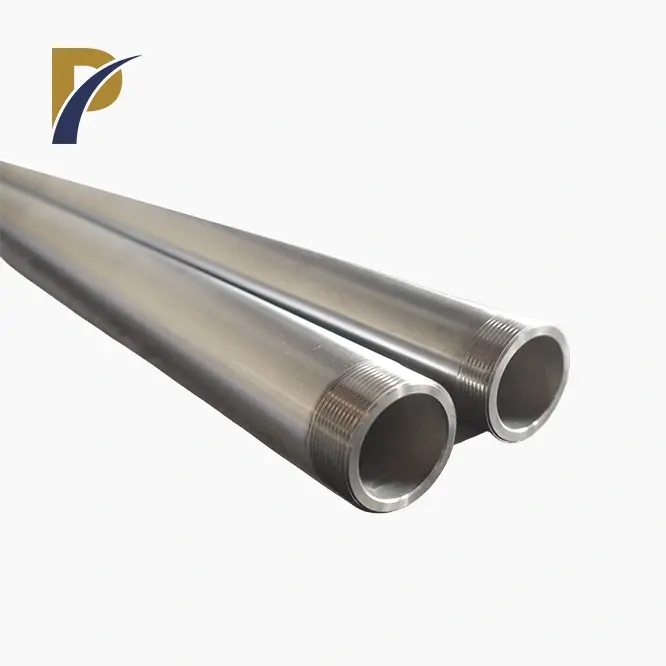Molybdenum tube targets are versatile components with a wide range of applications in various industries. These high-performance materials are primarily used in thin film deposition processes, particularly in the production of electronic devices, solar panels, and advanced optical coatings. The unique properties of molybdenum, such as its high melting point, excellent thermal conductivity, and low thermal expansion, make it an ideal choice for sputtering targets. High-purity molybdenum tube targets are especially crucial in semiconductor manufacturing, where they contribute to the creation of ultra-thin, uniform layers of molybdenum on substrates. Their applications extend to flat panel displays, touch screens, and even certain medical devices, showcasing the material's importance in cutting-edge technology development.
Advantages of Molybdenum Tube Targets in Thin Film Deposition
Superior Thermal Properties
Molybdenum tube targets excel in thin film deposition processes due to their exceptional thermal characteristics. The material's high melting point of approximately 2,623°C (4,753°F) allows it to withstand the intense heat generated during sputtering without degradation. This thermal stability ensures consistent performance and longevity of the target, even under demanding operating conditions. Moreover, molybdenum's excellent thermal conductivity facilitates uniform heat distribution across the target surface, promoting homogeneous film deposition and reducing the risk of localized hotspots that could compromise the quality of the resulting thin films.
Excellent Sputtering Yield
The sputtering yield of molybdenum tube targets is another significant advantage in thin film applications. Molybdenum atoms possess a relatively high atomic mass, which contributes to an efficient sputtering process. When bombarded with high-energy ions, molybdenum targets release a substantial number of atoms per incident ion, resulting in faster deposition rates compared to many other materials. This high sputtering yield not only enhances productivity but also allows for the creation of dense, well-adhered films with minimal defects. The efficiency of molybdenum in the sputtering process makes it a cost-effective choice for large-scale production environments.
Compatibility with Various Substrates
High-purity molybdenum tube targets demonstrate remarkable compatibility with a wide range of substrate materials. This versatility is particularly valuable in the electronics and semiconductor industries, where molybdenum films need to be deposited on diverse surfaces such as silicon, glass, and polymers. The low coefficient of thermal expansion of molybdenum helps minimize stress at the interface between the deposited film and the substrate, reducing the risk of delamination or cracking. This compatibility extends to both rigid and flexible substrates, enabling the production of advanced flexible electronics and displays that require precise control over film properties and adhesion.
 |
 |
Applications in Advanced Electronics and Semiconductor Industry
Thin Film Transistors (TFTs) for Display Technologies
Molybdenum tube targets play a crucial role in the fabrication of thin film transistors, which are fundamental components in modern display technologies. In liquid crystal displays (LCDs) and organic light-emitting diode (OLED) displays, molybdenum is often used as the gate electrode material in TFTs due to its low resistivity and excellent stability. The uniform films produced by high-purity molybdenum targets ensure consistent electrical properties across large display panels, contributing to improved picture quality and energy efficiency. The ability to deposit ultra-thin molybdenum layers with precise thickness control is particularly important in the development of high-resolution displays for smartphones, tablets, and large-format screens.
Interconnects and Barrier Layers in Integrated Circuits
In the semiconductor industry, molybdenum tube targets are utilized to create interconnects and barrier layers in integrated circuits. As device dimensions continue to shrink, the need for reliable, low-resistance interconnects becomes increasingly critical. Molybdenum's low electrical resistivity and resistance to electromigration make it an attractive alternative to traditional materials like aluminum in certain applications. Moreover, molybdenum films deposited using high-purity targets can serve as effective diffusion barriers, preventing the migration of copper atoms into the surrounding dielectric materials. This barrier function is essential for maintaining the integrity and performance of advanced microprocessors and memory devices.
Photovoltaic Cell Manufacturing
The solar energy sector benefits essentially from the application of molybdenum tube targets in photovoltaic cell generation. Molybdenum thin films are commonly utilized as back contacts in copper indium gallium selenide (CIGS) solar cells, one of the most promising thin-film solar innovations. The molybdenum layer serves different purposes in these cells: it acts as an ohmic contact, gives amazing adhesion to the glass substrate, and shapes a useful interface with the CIGS absorber layer. The utilize of high-purity molybdenum targets guarantees the statement of uniform, low-resistance films that contribute to moved forward solar cell proficiency and long-term steadiness. As the request for renewable energy sources develops, the part of molybdenum in solar cell manufacturing is anticipated to extend advance.
 |
 |
Emerging Applications and Future Prospects
Advanced Optical Coatings
Molybdenum tube targets are finding expanding utilize in the generation of progressed optical coatings. The interesting optical properties of thin molybdenum films, such as their high reflectivity in certain wavelength ranges, make them important in the advancement of specialized mirrors and filters. These coatings have applications in astronomical instruments, laser systems, and high-precision optical devices. The capacity to deposit ultra-thin, uniform molybdenum layers utilizing high-purity targets permits for the creation of complex multilayer structures with accurately controlled optical characteristics. As the request for modern optical components develops in areas like aviation, telecommunications, and scientific research, the significance of molybdenum-based coatings is likely to increase.
Wearable Technology and Flexible Electronics
The burgeoning field of wearable technology and flexible electronics presents new opportunities for molybdenum tube targets. The material's combination of electrical conductivity, flexibility when deposited in thin layers, and resistance to corrosion makes it suitable for creating conductive patterns on flexible substrates. These properties are essential for developing bendable displays, smart textiles, and wearable sensors. High-purity molybdenum targets enable the deposition of thin, uniform films that maintain their electrical properties even when subjected to repeated bending and flexing. As the wearable technology market continues to expand, the demand for materials that can meet the unique challenges of flexible electronics is expected to drive further innovation in molybdenum thin film applications.
Energy Storage Devices
Molybdenum tube targets are also gaining attention in the development of advanced energy storage devices. In particular, molybdenum-based thin films show promise as electrodes in next-generation batteries and supercapacitors. The material's high conductivity and stability in various electrolyte environments make it an attractive option for improving the performance and longevity of these energy storage systems. Molybdenum films deposited using high-purity targets can be engineered to have specific surface structures that enhance charge storage capacity and facilitate rapid charge/discharge cycles. As research into more efficient and sustainable energy storage solutions intensifies, the role of molybdenum in this field is likely to grow, potentially leading to breakthroughs in electric vehicle technology and grid-scale energy storage.
Conclusion
Molybdenum tube targets have established themselves as irreplaceable components in the generation of progressed thin films for a wide cluster of applications. From their pivotal part in semiconductor manufacturing and show innovations to developing employments in adaptable electronics and energy storage, these high-performance materials proceed to drive development over different businesses. The special properties of molybdenum, combined with the exactness advertised by high-purity targets, empower the creation of thin films with remarkable quality and usefulness. As innovation proceeds to advance, the flexibility and reliability of molybdenum tube targets guarantee their continuous noteworthiness in forming the future of electronics, renewable energy, and progressed materials.
Contact Us
To learn more about our high-quality molybdenum tube targets and how they can benefit your specific application, please don't hesitate to contact us. Our team of experts is ready to assist you in finding the perfect solution for your thin film deposition needs. Reach out to us at info@peakrisemetal.com for personalized support and product information.
References
Johnson, R. T. (2021). "Advanced Thin Film Deposition Techniques in Modern Electronics." Journal of Materials Science and Technology, 37(4), 215-229.
Zhang, L., et al. (2020). "High-Purity Molybdenum Targets for Next-Generation Display Technologies." Applied Surface Science, 512, 145721.
Patel, S. K., & Raman, A. (2019). "Molybdenum Thin Films in Photovoltaic Applications: Current Status and Future Prospects." Solar Energy Materials and Solar Cells, 201, 110087.
Chen, Y., et al. (2022). "Emerging Applications of Molybdenum-Based Thin Films in Flexible Electronics." Advanced Materials Interfaces, 9(12), 2101742.
Williams, E. D., & Thompson, C. V. (2018). "Molybdenum in Semiconductor Interconnects: Challenges and Opportunities." Annual Review of Materials Research, 48, 295-317.
Nakamura, H., et al. (2023). "Recent Advances in Molybdenum-Based Electrodes for Energy Storage Devices." Journal of Power Sources, 545, 232181.
